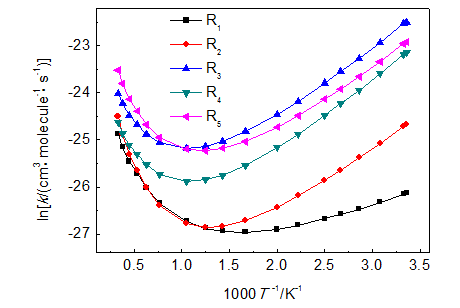| [1] Baasandorj, M.; Papanastasiou, D. K.; Talukdar, R. K.; Hasson, A. S.; Burkholder, J. B. Phys. Chem. Chem. Phys. 2010, 12, 12101.
[2] Roehl, C. M.; Marka1, Z.; Fry, J. L.; Wennberg, P. O. Atmos. Chem. Phys. 2007, 7, 713.
[3] Wang, C.; Chen, Z. Atmos. Environ. 2008, 42, 6614.
[4] Wang, C.; Chen, Z. Prog. Nat. Sci. 2006, 16, 1141.
[5] Lee, M.; Heikes, B. G.; O'Sullivan, D. W. Atmos. Environ. 2000, 34, 3475.
[6] Frey, M. M.; Stewart, R. W.; McConnell, J. R.; Bales, R. C. J. Geophys. Res. 2005, 110(D23), D23301.
[7] Butkovskaya, N. I.; Kukui, A.; Pouvesle, N.; Bras, G. L. J. Phys. Chem. A 2004, 108, 7021.
[8] Gross, A.; Mikkelsen, K. V.; Stockwell, W. R. Int. J. Quantum Chem. 2001, 84, 493.
[9] Ranzi, E.; Cavallotti, C.; Cuoci, A.; Frassoldati, A.; Pelucchi, M.; Faravelli, T. Combust. Flame. 2015, 162, 1679.
[10] Chen, D. N.; Jin, H. F.; Wang, Z. D.; Zhang, L. D.; Qi, F. J. Phys. Chem. A 2011, 115, 602.
[11] Alvarez-Idaboy, J. R.; Mora-Diez, N.; Boyd, R. J.; Vivier-Bunge, A. J. Am. Chem. Soc. 2001, 123, 2018.
[12] Bansch, C.; Kiecherer, J.; Szöri, M.; Olzmann, M. J. Phys. Chem. A 2013, 117, 8343.
[13] Alvarez-Idaboy, J. R.; Mora-Diez, N.; Vivier-Bunge, A. J. Am. Chem. Soc. 2000, 122, 3715.
[14] Galano, A.; Alvarez-Idaboy, J. R.; Francisco-Marquez, M. J. Phys. Chem. A 2010, 114, 7525.
[15] Greenwald, E. E.; North, S. W.; Georgievskii, Y.; Klippenstein, S. J. J. Phys. Chem. A 2005, 109, 6031.
[16] Greenwald, E. E.; North, S. W.; Georgievskii, Y.; Klippenstein, S. J. J. Phys. Chem. A 2007, 111, 5582.
[17] Shannon, R. J.; Taylor, S.; Goddard, A.; Blitz, M. A.; Heard, D. E. Phys. Chem. Chem. Phys. 2010, 12, 13511.
[18] Uc, V. H.; Alvarez-Idaboy, J. R.; Galano, A.; Garcia-Cruz, I.; Vivier-Bunge, A. J. Phys. Chem. A 2006, 110, 10155.
[19] Iuga, C.; Galano, A.; Vivier-Bunge, A. Chem. Phys. Chem. 2008, 9, 1453.
[20] Galano, A.; Alvarez-Idaboy, J. R.; Ruiz-Santoyo, M. E.; Vivier-Bunge, A. J. Phys. Chem. A 2002, 106, 9520.
[21] Olivella, S.; Sole, A. J. Chem. Theory. Comput. 2008, 4, 941.
[22] Vega-Rodriguez, A.; Alvarez-Idaboy, J. R. Phys. Chem. Chem. Phys. 2009, 11, 7649.
[23] Uc, V. H.; Garcia-Cruz, I.; Hernandez-Laguna, A.; Vivier-Bunge, A. J. Phys. Chem. A 2000, 104, 7847.
[24] Singleton, D. L.; Cvetanovic, R. J. J. Am. Chem. Soc. 1976, 98, 6812.
[25] Dente, M.; Bozzano, G.; Faravelli, T.; Marongiu, A.; Pierucci, S.; Ranzi, E. Adv. Chem. Eng. 2007, 32, 51.
[26] Niki, H.; Maker, P. D.; Savage, C. M.; Breltenbach, L. P. J. Phys. Chem. 1983, 87, 2190.
[27] Vaghjiani, G. L.; Ravishankara, A. R. J. Phys. Chem. 1989, 93, 1948.
[28] Baulch, D. L.; Bowman, C. T.; Cobos, C. J.; Cox, R. A.; Just, T.; Kerr, J. A.; Pilling, M. J.; Stocker, D.; Troe, J.; Tsang, W.; Walker, R. W.; Warnatz, J. J. Phys. Chem. Ref. Data. 2005, 34, 757.
[29] Luo, J.; Jia, X.; Gao, Y.; Song, G.; Yu, Y.; Wang, R.; Pan, X. J. Comput. Chem. 2011, 32, 987.
[30] Truong, T. N. J. Chem. Phys. 2000, 113, 4957.
[31] Muszynska, M.; Ratkiewicz, A.; Huynh, L. K.; Truong, T. N. J. Phys. Chem. A 2009, 113, 8327.
[32] Huynh, L. K.; Ratkiewicz, A.; Truong, T. N. J. Phys. Chem. A 2006, 110, 473.
[33] Wang, B. Y.; Li, Z. R.; Tan, N. X.; Yao, Q.; Li, X. Y. J. Phys. Chem. A 2013, 117, 3279.
[34] Sun, X. H.; Yao, Q.; Li, Z. R.; Wang, J. B.; Li, X. Y. Theor. Chem. Acc. 2017, 136, 64.
[35] Frisch, M. J.; Trucks, G. W.; Schlegel, H. B.; Scuseria, G. E.;Robb, M. A.; Cheeseman, J. R.; Scalmani, G.; Barone, V.; Mennucci,B.; Petersson, G. A.; Nakatsuji, H.; Caricato, M.; Li, X.; Hratchian, H.P.; Izmaylov, A. F.; Bloino, J.; Zheng, G.; Sonnenberg, J. L.; Hada, M.; Ehara, M.; Toyota, K.; Fukuda, R.; Hasegawa, Jr.; Ishida, M.; Nakajima, T.; Honda, Y.; Kitao, O.; Nakai, H.; Vreven, T.; Montgomery, J. A.; J.; Peralta, J. E.; Ogliaro, F.; Bearpark, M.; Heyd, J. J.; Brothers, E.; Kudin, K. N.; Staroverov, V. N.; Kobayashi, R.; Normand, J.; Raghavachari, K.; Rendell, A.; Burant, J. C.; Iyengar, S. S.; Tomasi, J.; Cossi, M.; Rega, N.; Millam, J. M.; Klene, M.; Knox, J. E.; Cross, J. B.; Bakken, V.; Adamo, C.; Jaramillo, J.; Gomperts, R.; Stratmann, R. E.; Yazyev, O.; Austin, A. J.; Cammi, R.; Pomelli, C.; Ochterski, J. W.; Martin, R. L.; Morokuma, K.; Zakrzewski, V. G.; Voth, G. A.; Salvador,P.; Dannenberg, J. J.; Dapprich, S.; Daniels, A. D.; Farkas, O.;Foresman, J. B.; Ortiz, J. V.; Cioslowski, J.; Fox, D. J. Gaussian 09, Revision A. 1, Gaussian Inc., Wallingford, CT, 2009.
[36] Merrick, J. P.; Moran, D.; Radom, L. J. Phys. Chem. A 2007, 111, 11683.
[37] Truhlar, D. G. Chem. Phys. Lett. 1998, 294, 45.
[38] Huh, S. B.; Lee, J. S. J. Chem. Phys. 2003, 118, 3035.
[39] Wigner, E. J. Chem. Phys. 1937, 5, 720. |
